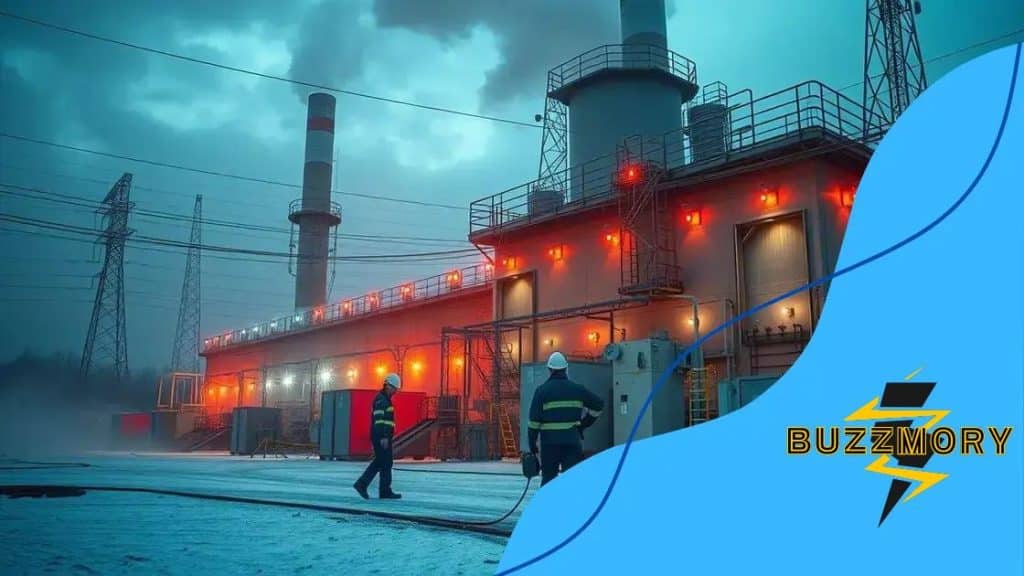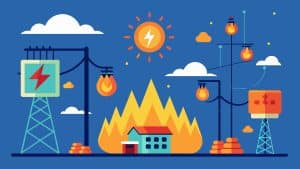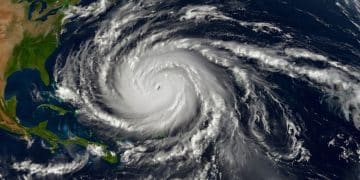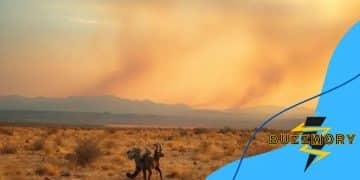National energy emergency order: what it means for you


The National Energy Emergency Order is a vital measure that governments can implement during critical situations to ensure energy security.
This order allows for coordinated actions to manage energy supplies, implement conservation measures, and protect public safety.
With the growing concerns about energy disruption due to events like Hurricane Erin, it’s important for individuals to understand how this order impacts them and their communities.
By understanding the order’s scope, you can be better prepared for the effects it may have on your daily life.
Understanding the national energy emergency order
Understanding the National Energy Emergency Order is crucial for recognizing how energy management is handled during crises.
This order allows the government to step in and take swift action to secure and stabilize energy resources during times of significant disruption.
When triggered, it empowers federal agencies to act promptly, helping ensure that energy supplies are maintained, and any shortage is mitigated.
The order represents an important tool in ensuring that communities and businesses can continue to operate even in the face of emergency situations that affect energy distribution.
What Triggers the Order?
The National Energy Emergency Order can be activated by various events that threaten the stability of the nation’s energy systems.
This includes natural disasters like hurricanes or earthquakes, which can devastate infrastructure and disrupt the supply of energy.
Additionally, geopolitical tensions, such as conflicts in regions that supply vital oil or natural gas, can trigger this order, as can significant outages of major power sources, such as nuclear or coal plants.
These events can lead to substantial shifts in energy supply, demanding a coordinated and rapid response from the government.
The primary objective of the order in these situations is to ensure that energy continues to flow where it is most needed, preventing shortages that could severely affect communities and businesses.
The National Energy Emergency Order acts as a safeguard, ensuring that essential services and public safety are maintained even when energy resources are stretched thin due to unexpected disruptions.
Roles of Government Agencies
When a National Energy Emergency Order is declared, multiple government agencies play distinct roles to help manage the crisis.
The Department of Energy (DOE), for instance, takes the lead in assessing the energy situation and coordinating resources across the country.
Their role includes monitoring the status of the energy supply, working with local authorities to assess the impact of the emergency, and implementing energy conservation measures to stretch available resources.
Besides the DOE, agencies like the FERC and EPA play key roles in managing the energy supply, protecting critical infrastructure, and enforcing conservation measures.
Local authorities also have an important role in coordinating with these federal agencies, ensuring that local needs are met and that energy is distributed equitably during times of crisis.
While federal agencies are tasked with overseeing and managing energy distribution, it’s also important for local communities to contribute. Being informed about the situation and understanding the energy conservation measures in place can help reduce overall demand and ensure that energy resources are available for the most critical needs. Communities can take action by following guidelines for reducing consumption, ensuring that energy is used more efficiently, and remaining adaptable during periods of uncertainty.
Empowering Communities Through Awareness
The National Energy Emergency Order not only empowers federal agencies to act swiftly but also calls for community cooperation. Awareness is key for individuals and households to prepare for changes in energy availability.
Educating oneself about energy-efficient practices is essential during emergencies, as even small reductions in consumption can have a significant impact on managing available resources.
For example, reducing electricity usage by turning off lights when not in use, limiting heating or cooling systems to essential areas, and using energy-efficient appliances can help ease the strain on the grid.
By taking these proactive steps, individuals can contribute to the broader effort of maintaining energy security during times of crisis.
Understanding how the National Energy Emergency Order works and the role each person plays in it can ensure that energy resources are used effectively, helping to safeguard the energy supply for everyone.
The National Energy Emergency Order thus plays a pivotal role in managing energy crises and ensuring that energy supplies remain stable during emergencies.
By understanding how it works and following conservation practices, individuals and communities can help reduce the impact of such disruptions on their daily lives.
Impacts on energy supply and safety
The impacts on energy supply and safety are significant when a National Energy Emergency Order is activated.
This order can lead to challenges in how energy is distributed and consumed, often causing disruptions that require careful management.
Understanding these effects helps individuals and communities prepare for the challenges they may face during a crisis.
Effects on Energy Supply
When a National Energy Emergency Order is in place, several factors can strain energy supplies, leading to potential shortages.
Disruptions may occur due to sudden increases in demand, such as when businesses and households increase their consumption in response to the crisis. People may also begin stockpiling energy sources, further exacerbating the situation.
The surge in demand can lead to shortages of essential resources like fuel, increasing prices due to limited availability. In response, energy providers might implement rolling blackouts to manage the supply.
These blackouts, though inconvenient, are a way to prevent longer-lasting outages and ensure that energy remains available for critical services.
These challenges emphasize the importance of energy conservation during such times.
By being mindful of how much energy is used, every individual can play a role in helping to manage consumption, ensuring that available resources are used as efficiently as possible.
Safety Concerns
Along with the impact on energy supply, safety becomes a primary concern during a National Energy Emergency Order. Power outages and disruptions to essential services can increase risks for individuals and families.
It’s essential to take precautionary measures to stay safe when energy systems are strained.
One of the first steps in preparing for a potential outage is to keep emergency supplies on hand, including items like flashlights, extra batteries, and non-perishable food.
Staying informed is also vital, as updates from reliable news sources can help you understand the current situation and any recommendations from local authorities.
Having a communication plan in place with family members ensures that everyone knows how to stay in touch in case of an emergency.
Awareness of these safety measures can make a substantial difference in how well individuals and families can manage without power.
When you understand the potential risks and take the necessary precautions, you can feel more secure and better equipped to navigate the challenges posed by the National Energy Emergency Order.
This preparedness is essential not only for personal safety but also for the overall resilience of communities in times of crisis.
By recognizing the impacts on energy supply and safety, you can take proactive steps to adapt to changing circumstances.
Education, preparedness, and conservation efforts help individuals and communities respond effectively, ensuring better outcomes during energy emergencies.
How communities can prepare

Communities play a vital role in adapting effectively during a National Energy Emergency Order. The ability of neighborhoods to work together and plan ahead can significantly impact how well they manage energy disruptions and ensure public safety.
When residents come together, they can create comprehensive plans that address energy shortages, safety concerns, and resource management, helping to protect everyone in the community.
Creating Emergency Plans
A key step in preparing for a National Energy Emergency Order is for communities to develop emergency plans.
These plans should clearly outline how the community will respond to energy shortages and safety issues, and provide guidelines for managing resources efficiently.
Local leaders can take charge of facilitating group discussions to draft these plans, ensuring that all residents understand their roles and responsibilities in a crisis.
Designating emergency contacts within the neighborhood is crucial, as this ensures that residents know who to reach out to for help or coordination.
A communication strategy must also be established to keep everyone updated on the latest developments.
It’s important to designate a safe meeting point where community members can gather in case of evacuation or when communication is interrupted.
By sharing this information in advance, communities can foster a sense of security and preparedness among residents, ensuring that everyone is on the same page during an emergency.
Building Resource Networks
Building resource-sharing networks is another effective strategy for community preparedness during a National Energy Emergency Order.
When neighbors collaborate and pool their resources, they can help reduce the strain on individuals and ensure that everyone has access to essential supplies.
Resource-sharing networks allow people to share tools, food, and knowledge, alleviating pressure on local resources during crises.
For example, neighbors can share food supplies to ensure no one runs out of essentials. Transportation assistance can be provided to those without vehicles, especially if evacuations or travel to critical locations are necessary.
Communities can also exchange energy conservation tips, which will help reduce overall consumption and ensure that resources are stretched over a longer period.
Not only do these networks provide practical support, but they also foster cooperation and strengthen community bonds.
Strong relationships within the neighborhood make it easier for individuals to reach out for help when needed, and they help everyone feel more connected and supported during difficult times.
Empowering Communities through Education
Educating residents on how to prepare for energy shortages is a powerful tool in managing the effects of a National Energy Emergency Order.
By organizing workshops on energy efficiency, emergency preparedness, and conservation practices, communities can empower their members to actively contribute to the overall preparedness plan.
This collective knowledge helps ensure that all individuals know how to conserve energy effectively, how to use essential resources wisely, and how to navigate the emergency response system.
Communities that are well-informed and prepared are better equipped to handle the challenges posed by a National Energy Emergency Order.
Through coordinated efforts, emergency planning, and resource-sharing, neighborhoods can significantly reduce the impact of energy disruptions and build a resilient community capable of responding effectively in times of crisis.
Government responsibilities during the order
During a National Energy Emergency Order, the government is entrusted with significant responsibilities to manage energy resources effectively. These responsibilities encompass a wide range of actions aimed at maintaining energy supply, protecting public safety, and ensuring that essential services remain operational. The government’s role is critical in responding to the energy challenges that arise during such emergencies, and its actions set the tone for how well communities can adapt to and navigate through these disruptions.
Coordinating Energy Resources
One of the primary duties of the government during a National Energy Emergency Order is to coordinate energy resources across various sectors. This involves extensive collaboration with energy providers, local authorities, and other stakeholders to assess available energy supplies and implement effective distribution strategies. The main goal is to ensure that energy reaches the areas that need it the most, especially during times of heightened demand or significant disruptions.
A crucial part of this coordination includes establishing communication with energy companies to monitor supply levels and consumption rates, allowing for a real-time understanding of energy demand. Additionally, the government may implement priority restoration plans for critical infrastructure, such as hospitals, emergency response centers, and essential services. This targeted approach helps prevent major shortages, ensuring that vital sectors continue functioning even when resources are stretched thin.
By ensuring efficient coordination between public and private entities, the government can mitigate the worst effects of a national energy crisis, stabilizing energy distribution and minimizing disruptions to everyday life.
Implementing Conservation Measures
In addition to coordinating energy distribution, the government also plays a vital role in implementing energy conservation measures during a National Energy Emergency Order.
During such emergencies, the demand for energy often exceeds supply, making conservation efforts critical.
The government encourages individuals, households, and businesses to reduce their energy usage in order to extend available resources and prevent more widespread shortages.
This can be achieved through public awareness campaigns that highlight the importance of conserving energy.
The government may also provide incentives for energy-saving technologies, promoting the use of energy-efficient appliances, lighting, and heating systems.
Issuing guidelines for reduced energy consumption during peak hours is another common tactic. For example, businesses might be encouraged to adopt flexible work hours to help ease the overall demand on energy during high-usage periods.
By focusing on conservation, the government helps balance supply and demand, ensuring that available energy is used as efficiently as possible.
This can prevent the need for more drastic measures, such as rolling blackouts, while also extending the period during which energy supplies remain stable.
Maintaining Transparency and Communication
During a National Energy Emergency Order, the government must maintain transparency and provide consistent updates to the public.
Keeping citizens informed about the current energy status and any changes to energy policies or conservation guidelines is essential in helping individuals make informed decisions about their energy use.
Regular updates through news briefings and official channels help to calm public concerns, allowing people to understand the steps being taken to manage the crisis and what they can do to contribute to energy conservation efforts.
Clear communication from the government is crucial in managing public expectations and reducing anxiety during uncertain times.
Enhancing Resilience through Proactive Measures
The government’s actions during a National Energy Emergency Order directly influence the effectiveness of community responses to energy crises.
By proactively coordinating resources, encouraging conservation, and maintaining clear communication, the government strengthens the resilience of the entire energy system.
When the government takes decisive steps to manage resources and guide public behavior, it not only helps mitigate the immediate effects of the crisis but also lays the foundation for a more sustainable energy future.
In summary, the government’s responsibilities during a National Energy Emergency Order are crucial to minimizing disruptions, ensuring safety, and maintaining public confidence during energy challenges.
By acting swiftly and effectively, the government plays a central role in maintaining energy security and enabling communities to adapt to the demands of a national emergency.
What Individuals Can Do During a National Energy Emergency Order

During a National Energy Emergency Order, individuals play a vital role in managing energy consumption and supporting the community.
The steps you take can make a significant difference in how effectively you and those around you cope with the situation.
By staying informed, conserving energy, and preparing in advance, you contribute to both your own safety and the collective resilience of your community.
Stay Informed
The first crucial step is to stay informed about the ongoing energy situation. This involves regularly checking news reports, updates from local authorities, and other trusted sources for the latest information on energy availability.
Being informed helps you make better decisions about your daily energy usage and any actions you may need to take in response to the emergency.
Make sure to monitor social media updates from reliable news outlets and government agencies. These platforms often provide real-time alerts and updates.
Sign up for emergency alerts from local authorities to receive direct notifications about power status, energy-saving guidelines, and any immediate action you may need to take.
Checking local news websites for power updates also helps you stay on top of local conditions and potential energy disruptions.
Staying informed ensures that you are aware of any recommended actions from government agencies and local authorities, which helps you adapt to changing circumstances effectively.
Practice Energy Conservation
Energy conservation is one of the most impactful actions individuals can take during a National Energy Emergency Order.
When energy supplies are under pressure, reducing your consumption helps alleviate the demand on the power grid, extending available resources and preventing major shortages.
Even small adjustments can significantly contribute to the overall stability of the energy system.
Turning off lights in unoccupied rooms, using energy-efficient appliances, and limiting the use of heating or cooling systems are simple yet effective ways to conserve energy.
Additionally, consider adjusting your thermostat to lower temperatures in winter or raise them in summer, which can reduce the energy required for heating and cooling.
These energy-saving practices help reduce the load on the grid, making more energy available for critical services and preventing widespread outages.
Prepare an Emergency Kit
In addition to energy conservation, it’s important to prepare an emergency kit. Having essential supplies on hand can help you and your family navigate through power outages and other disruptions more smoothly.
Pack items such as water, non-perishable food, medications, and batteries. Be sure to keep these items readily accessible in case of an emergency.
By preparing an emergency kit, you can save valuable time and reduce stress during an energy crisis. Consider creating a checklist of essential items and updating it regularly to ensure you have everything you might need in a time of crisis.
Build Community Support
Being proactive in your preparations not only benefits you but also strengthens your community. Encourage your friends, neighbors, and family members to follow similar steps to stay informed and conserve energy.
Building a support network is crucial during emergencies, as it fosters cooperation and ensures that no one is left behind.
By taking individual steps to stay prepared, you contribute to a stronger, more resilient community that can adapt effectively to the challenges posed by a National Energy Emergency Order.
Conclusion
In conclusion, the National Energy Emergency Order is a critical tool used by the government to ensure energy security and stability during crises.
By understanding the order’s scope and its impacts on energy supply, safety, and public policy, individuals and communities can take proactive steps to prepare for potential disruptions.
Whether through energy conservation, staying informed, or building community networks, every action contributes to managing the challenges that arise during such emergencies.
The government’s efforts, along with community cooperation, play a pivotal role in maintaining essential services and ensuring that energy resources are distributed effectively.
For a better understanding of how these measures will impact you and your community, it’s important to stay updated with information from trusted sources.
The National Energy Emergency Order may require adjustments to how we manage energy consumption, but with the right preparation, we can face these challenges together.
For more detailed information on the declaration and its implications, you can explore resources such as The White House and Columbia Law, where updates and expert analysis provide deeper insights into the emergency response measures that are shaping our energy future.
FAQ – Frequently Asked Questions about National Energy Emergency Orders
What is a national energy emergency order?
A national energy emergency order is a governmental declaration that allows for coordinated actions to manage energy supplies during critical situations.
How can individuals prepare for a national energy emergency?
Individuals can prepare by staying informed, conserving energy, and having an emergency kit ready with essential supplies.
What responsibilities does the government have during a national energy emergency?
The government is responsible for coordinating energy resources, implementing conservation measures, and ensuring public safety through communication.
Why is community cooperation important during an energy emergency?
Community cooperation enhances resilience, as neighbors can share resources and information to support each other during energy shortages.
Liked the article?





